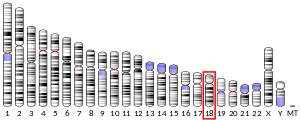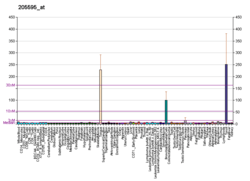Desmoglein-3
Desmoglein-3 is a protein that in humans is encoded by the DSG3 gene.[4][5] In the skin epidermis Desmoglein-3 is expressed in the basal lower layers of the epidermis, and dominates in terms of expression on mucosal surfaces compared to Desmoglein-1.[6]
| DSG3 | |||||||||||||||||||||||||
|---|---|---|---|---|---|---|---|---|---|---|---|---|---|---|---|---|---|---|---|---|---|---|---|---|---|
| |||||||||||||||||||||||||
| Identifiers | |||||||||||||||||||||||||
| Aliases | DSG3, CDHF6, PVA, desmoglein 3 | ||||||||||||||||||||||||
| External IDs | OMIM: 169615 MGI: 99499 HomoloGene: 55513 GeneCards: DSG3 | ||||||||||||||||||||||||
| |||||||||||||||||||||||||
| |||||||||||||||||||||||||
| |||||||||||||||||||||||||
| Orthologs | |||||||||||||||||||||||||
| Species | Human | Mouse | |||||||||||||||||||||||
| Entrez | |||||||||||||||||||||||||
| Ensembl |
| ||||||||||||||||||||||||
| UniProt | |||||||||||||||||||||||||
| RefSeq (mRNA) | |||||||||||||||||||||||||
| RefSeq (protein) | |||||||||||||||||||||||||
| Location (UCSC) | Chr 18: 31.45 – 31.48 Mb | n/a | |||||||||||||||||||||||
| PubMed search | [2] | [3] | |||||||||||||||||||||||
| Wikidata | |||||||||||||||||||||||||
| |||||||||||||||||||||||||
Function
Desmosomes are cell-cell junctions between epithelial, myocardial, and certain other cell types. Desmoglein 3 is a calcium-binding transmembrane glycoprotein component of desmosomes in vertebrate epithelial cells. Currently, four desmoglein subfamily members have been identified and all are members of the cadherin cell adhesion molecule superfamily. These desmoglein gene family members are located in a cluster on chromosome 18. This protein, along with Desmoglein-1, has been identified as the autoantigen of the autoimmune skin blistering disease pemphigus vulgaris.[7] The mucosal dominant form of pemphigus vulgaris only involves antibodies against Desmoglein-3 and causes mucosal erosions, but no skin lesions.[6] Desmoglein-3 serves as a prognostic marker of Esophageal Squamous Cell Carcinoma (ESCC), and may even be involved in the progression of ESCC.[8]
Pathogenicity
Pathogenicity of Desmoglein-3 antibodies comes from the existence of a tryptophan residue that could be interacting with the binding pocket that is necessary for trans-interaction of Desmoglein molecules.[9] Such antibodies can lead to the cause of skin disorders like pemphigus vulgaris.
Interactions
Desmoglein 3 has been shown to interact with PKP3.[10]
See also
- Desmoglein
- List of target antigens in pemphigus
- List of conditions caused by problems with junctional proteins
References
- GRCh38: Ensembl release 89: ENSG00000134757 - Ensembl, May 2017
- "Human PubMed Reference:". National Center for Biotechnology Information, U.S. National Library of Medicine.
- "Mouse PubMed Reference:". National Center for Biotechnology Information, U.S. National Library of Medicine.
- Arnemann J, Spurr NK, Buxton RS (May 1992). "The human gene (DSG3) coding for the pemphigus vulgaris antigen is, like the genes coding for the other two known desmogleins, assigned to chromosome 18". Human Genetics. 89 (3): 347–50. doi:10.1007/bf00220557. PMID 1601426.
- "Entrez Gene: DSG3 desmoglein 3 (pemphigus vulgaris antigen)".
- Beigi PK (2018). A Clinician's Guide to Pemphigus Vulgaris. Springer, Cham. pp. 3–10. doi:10.1007/978-3-319-67759-0_1. ISBN 9783319677583.
- Hartlieb E, Kempf B, Partilla M, Vigh B, Spindler V, Waschke J (2013-01-11). "Desmoglein 2 is less important than desmoglein 3 for keratinocyte cohesion". PLOS ONE. 8 (1): e53739. Bibcode:2013PLoSO...853739H. doi:10.1371/journal.pone.0053739. PMC 3543261. PMID 23326495.
- Fang WK, Gu W, Liao LD, Chen B, Wu ZY, Wu JY, Shen J, Xu LY, Li EM (2014). "Prognostic significance of desmoglein 2 and desmoglein 3 in esophageal squamous cell carcinoma". Asian Pacific Journal of Cancer Prevention. 15 (2): 871–6. doi:10.7314/apjcp.2014.15.2.871. PMID 24568510.
- Spindler V, Rötzer V, Dehner C, Kempf B, Gliem M, Radeva M, Hartlieb E, Harms GS, Schmidt E, Waschke J (February 2013). "Peptide-mediated desmoglein 3 crosslinking prevents pemphigus vulgaris autoantibody-induced skin blistering". The Journal of Clinical Investigation. 123 (2): 800–11. doi:10.1172/jci60139. PMC 3561799. PMID 23298835.
- Bonné S, Gilbert B, Hatzfeld M, Chen X, Green KJ, van Roy F (April 2003). "Defining desmosomal plakophilin-3 interactions". The Journal of Cell Biology. 161 (2): 403–16. doi:10.1083/jcb.200303036. hdl:1854/LU-210987. PMC 2172904. PMID 12707304.
Further reading
- Amagai M, Klaus-Kovtun V, Stanley JR (November 1991). "Autoantibodies against a novel epithelial cadherin in pemphigus vulgaris, a disease of cell adhesion". Cell. 67 (5): 869–77. doi:10.1016/0092-8674(91)90360-B. PMID 1720352.
- Roh JY, Stanley JR (May 1995). "Plakoglobin binding by human Dsg3 (pemphigus vulgaris antigen) in keratinocytes requires the cadherin-like intracytoplasmic segment". The Journal of Investigative Dermatology. 104 (5): 720–4. doi:10.1111/1523-1747.ep12606963. PMID 7738346.
- Wang Y, Amagai M, Minoshima S, Sakai K, Green KJ, Nishikawa T, Shimizu N (April 1994). "The human genes for desmogleins (DSG1 and DSG3) are located in a small region on chromosome 18q12". Genomics. 20 (3): 492–5. doi:10.1006/geno.1994.1207. PMID 8034325.
- Schäfer S, Koch PJ, Franke WW (April 1994). "Identification of the ubiquitous human desmoglein, Dsg2, and the expression catalogue of the desmoglein subfamily of desmosomal cadherins". Experimental Cell Research. 211 (2): 391–9. doi:10.1006/excr.1994.1103. PMID 8143788.
- Kárpáti S, Amagai M, Prussick R, Cehrs K, Stanley JR (July 1993). "Pemphigus vulgaris antigen, a desmoglein type of cadherin, is localized within keratinocyte desmosomes". The Journal of Cell Biology. 122 (2): 409–15. doi:10.1083/jcb.122.2.409. PMC 2119642. PMID 8320263.
- Silos SA, Tamai K, Li K, Kivirikko S, Kouba D, Christiano AM, Uitto J (July 1996). "Cloning of the gene for human pemphigus vulgaris antigen (desmoglein 3), a desmosomal cadherin. Characterization of the promoter region and identification of a keratinocyte-specific cis-element". The Journal of Biological Chemistry. 271 (29): 17504–11. doi:10.1074/jbc.271.29.17504. PMID 8663392.
- Marsden MD, Collins JE, Greenwood MD, Adams MJ, Fleming TP, Magee AI, Buxton RS (February 1997). "Cloning and transcriptional analysis of the promoter of the human type 2 desmocollin gene (DSC2)". Gene. 186 (2): 237–47. doi:10.1016/S0378-1119(96)00715-9. PMID 9074502.
- Adams MJ, Reichel MB, King IA, Marsden MD, Greenwood MD, Thirlwell H, Arnemann J, Buxton RS, Ali RR (January 1998). "Characterization of the regulatory regions in the human desmoglein genes encoding the pemphigus foliaceous and pemphigus vulgaris antigens". The Biochemical Journal. 329. 329 ( Pt 1): 165–74. doi:10.1042/bj3290165. PMC 1219028. PMID 9405290.
- Shirakata Y, Amagai M, Hanakawa Y, Nishikawa T, Hashimoto K (January 1998). "Lack of mucosal involvement in pemphigus foliaceus may be due to low expression of desmoglein 1". The Journal of Investigative Dermatology. 110 (1): 76–8. doi:10.1046/j.1523-1747.1998.00085.x. PMID 9424092.
- Amagai M, Nishikawa T, Nousari HC, Anhalt GJ, Hashimoto T (August 1998). "Antibodies against desmoglein 3 (pemphigus vulgaris antigen) are present in sera from patients with paraneoplastic pemphigus and cause acantholysis in vivo in neonatal mice". The Journal of Clinical Investigation. 102 (4): 775–82. doi:10.1172/JCI3647. PMC 508940. PMID 9710446.
- Ishikawa H, Li K, Tamai K, Sawamura D, Uitto J (August 2000). "Cloning of the mouse desmoglein 3 gene (Dsg3): interspecies conservation within the cadherin superfamily". Experimental Dermatology. 9 (4): 229–39. doi:10.1034/j.1600-0625.2000.009004229.x. PMID 10949543.
- Czerwenka KF, Manavi M, Hosmann J, Jelincic D, Pischinger KI, Battistutti WB, Behnam M, Kubista E (2001). "Comparative analysis of two-dimensional protein patterns in malignant and normal human breast tissue". Cancer Detection and Prevention. 25 (3): 268–79. PMID 11425269.
- Weiske J, Schöneberg T, Schröder W, Hatzfeld M, Tauber R, Huber O (November 2001). "The fate of desmosomal proteins in apoptotic cells". The Journal of Biological Chemistry. 276 (44): 41175–81. doi:10.1074/jbc.M105769200. PMID 11500511.
- Andl CD, Stanley JR (November 2001). "Central role of the plakoglobin-binding domain for desmoglein 3 incorporation into desmosomes". The Journal of Investigative Dermatology. 117 (5): 1068–74. doi:10.1046/j.0022-202x.2001.01528.x. PMID 11710914.
- Merritt AJ, Berika MY, Zhai W, Kirk SE, Ji B, Hardman MJ, Garrod DR (August 2002). "Suprabasal desmoglein 3 expression in the epidermis of transgenic mice results in hyperproliferation and abnormal differentiation". Molecular and Cellular Biology. 22 (16): 5846–58. doi:10.1128/MCB.22.16.5846-5858.2002. PMC 133994. PMID 12138195.
- Hanakawa Y, Amagai M, Shirakata Y, Yahata Y, Tokumaru S, Yamasaki K, Tohyama M, Sayama K, Hashimoto K (December 2002). "Differential effects of desmoglein 1 and desmoglein 3 on desmosome formation". The Journal of Investigative Dermatology. 119 (6): 1231–6. doi:10.1046/j.1523-1747.2002.19648.x. PMID 12485422.
- Veldman C, Stauber A, Wassmuth R, Uter W, Schuler G, Hertl M (January 2003). "Dichotomy of autoreactive Th1 and Th2 cell responses to desmoglein 3 in patients with pemphigus vulgaris (PV) and healthy carriers of PV-associated HLA class II alleles". Journal of Immunology. 170 (1): 635–42. doi:10.4049/jimmunol.170.1.635. PMID 12496453.
- Posthaus H, Dubois CM, Müller E (February 2003). "Novel insights into cadherin processing by subtilisin-like convertases". FEBS Letters. 536 (1–3): 203–8. doi:10.1016/S0014-5793(02)03897-8. PMID 12586364.


